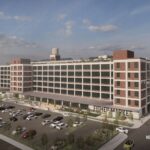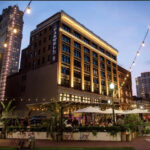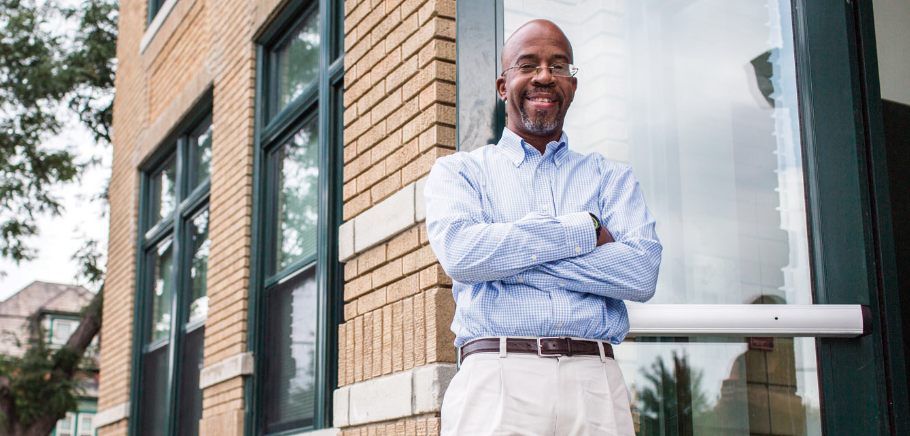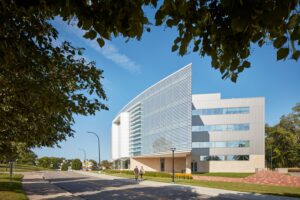The career of Richard Hosey, owner of Hosey Development LLC, has spanned development, consulting, financing, and asset management of more than 75 projects in Detroit totaling over $2.5 billion in development costs.
His most recent undertaking is the renovation of the former Fisher Body 21 plant, a $134 million project that will preserve and redevelop the plant into approximately 435 rental apartments; 38,000 square feet of commercial space; outdoor and indoor amenities; and up to 139 interior and 646 adjacent surface parking spaces. At least 20% of rental units will be affordable for those earning no more than 80% of the area median income ($51,200 or less for a two-person household).
SBN Detroit spoke to Hosey about his work and his impact on sustainability in Detroit.

Q: Tell us about Hosey Development.
A: I’ve been in real estate since 1996, and then I worked for Bank of America from 2005 to 2013 investing in urban development. That job brought me back to Detroit in 2008. I remember arguing with a city councilperson on why the Lafayette Building should not be torn down, and that it should be invested in and rehabbed. She said to me, ‘Would you do it?’ and I thought, yes, I need to stop complaining and start doing something. I started with the Kirby Center Lofts, which was an old Hebrew School in Midtown, and then it became a process after that.
Q: Talk about preserving affordable housing in Detroit and how you work to do this.
A: In 2008, the city was only building affordable housing, which created concentrated poverty.
On the other hand, as the market rate takes off, we need to ensure that it’s reasonably and rationally balanced so housing doesn’t become unaffordable. Revitalization tends to push out affordability, but the City of Detroit has an affordability requirement inside every project to ensure this doesn’t happen.
I love the work of the Detroit Land Bank. Affordable housing should not just be apartment living. With programs like Rehab and Ready, they are going into neighborhoods and driving change.
Q: You provide financing for your subcontractors. Can you tell us about that?
A: I focus on employing Detroiters. Detroit has plenty of construction talent, but there are not plenty of contractors with the capacity to carry a big job. There is an upfront economic load that comes with larger jobs, such as purchasing materials and paying for labor that many – most – construction companies in Detroit can’t shoulder.
For my first project – the Kirby Center – I started thinking what if I carry the job? I then met Mel Washington, a local developer who walked me through the process of doing so.
Now, my partner and I are using this same concept on the Fisher 21 project. We are using companies that have the skills and the organization to do a big job like this but can’t buy $1 million in HVAC equipment upfront and get paid later. So we do that part.

It’s been great working this way. We get Detroit companies who do great work.
Q: How do you think sustainability plays into what you do?
A: As we build up the ecosystem such that our contractors in Detroit are getting the jobs, the economics go in a circle. Good-paying jobs mean the workers buy homes here, buy cars here, and spend their money here. That’s the ideal model.
For a lot of years, construction companies would come into the city, make their money, and go back to their homes in Oakland County or Macomb County. The key is to keep it in Detroit so the dollars stay in the community and circulate.
From an environmental standpoint, rehabbing a building versus tearing it down is much better for our planet. The challenge comes with being good to the tenant while being good to the planet. For example, we can put in huge beautiful windows, but how high is the electric bill going to be? We then need to find solutions for the most efficient furnace so the tenant isn’t impacted by a huge expense.
Q: The redevelopment of the Fisher plant is the largest Black-led development in the city. What is the importance of this?
A: I want this to become the everyday normal. So many processes focus on the idea that there is no talent or capacity in Detroit.
I hope to be able to show that larger projects can be handled by Black and Brown teams. We still have a long way to go. The Fisher project at $135 million is just 3% of the $5 billion in development announced in the last twelve months. But I hope to build a model for black funders and black talent to come together.
Q: What is the future of Hosey Development?

A: I will be in this market for the long run. I picture myself exclusively in Detroit except for one thing – mentoring new and existing developers. Again, I will feel more successful when more Black and Brown people and women are involved in development in the city.
And it’s happening. Many small and midlevel Black and Brown developers are coming into Detroit in ways you don’t see in other cities. Diverse developers are landing here because they can get a foothold. Preserving that should be a priority.
Removing barriers and growing talent based on ability as opposed to inherited wealth is one of the most important things we can provide in this market.
Be sure to subscribe to our newsletter for regular updates on sustainable business practices in and around Detroit.









